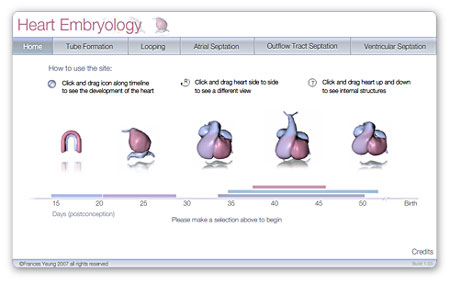Recent updates
October 21, 2010
Cardiac Embryology has been restructured and relaunched.
Cardiac Embryology
Welcome
Welcome to the Cardiac Embryology website. This site is a resource for educators and students looking for tools that facilitate the teaching and learning of cardiac embryology.
Note: This module was developed with Adobe Flash, and Flash is no longer supported by web browsers. However, there is a new Flash emulator called Ruffle which is under development. Currently, the Cardiac Embryology, Virtual Liver, Virtual Bronchoscopy, and POPS simulation are the only PIE Flash modules that work with Ruffle, but as development is ongoing, future releases of Ruffle will work with other PIE modules. This will be indicated on the web page for each module.
Issues with the Cardiac Embryology: Each of the modules loads with a red box covering much of the module, but if you click on the “Labels off” button, the red box goes away and the module functions normally. The labels are on, and you can rotate the 3D model by dragging you mouse horizontally over the model. Clicking on each day in the timeline will show the model for that point in the timeline. (The “Ventral view” button doesn’t work.) The module has useful functionality, and hopefully more features will work as they update the Chrome extension in the coming months.
Ruffle can be installed as an extension to the Chrome browser which will allow these modules to play. This extension can be downloaded from the Chrome Web Store:

Click on the image above to open Heart Embryology.
The project provides a 3D interactive model at each of three stages of tube formation, three stages of looping, two stages of artial septation and two stages of ventricular septation, with continuous transitions provided between each of the 10 stages. At each stage the user is able to rotate the model to view it from any angle and change the transparency of the heart to see the chambers and internal structures.
If you would like to use this application in a classroom setting, a larger version of the Heart Embryology application can be found here. This version may be more suitable for projection media.


